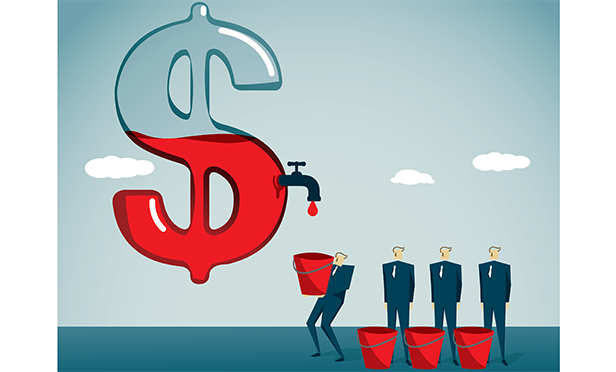
The Federal Reserve unleashed two emergency lending programs on Tuesday to help keep credit flowing to the U.S. economy amid strain in financial markets that it blamed on the coronavirus pandemic.
The central bank is using emergency authorities to establish a Commercial Paper Funding Facility with the approval of the Treasury secretary, according to a Fed statement on Tuesday. The Treasury will provide $10 billion of credit protection from its Exchange Stabilization Fund. Later in the day it announced a Primary Dealer Credit Facility, also with backing from Treasury.
The moves follow mounting pressure to act, after the Fed's Sunday evening emergency interest-rate cut to nearly zero and other measures failed to stem market stress as investors reacted to the risk that the virus will tip the United States and global economy into a recession.
"We heard loud and clear there were liquidity issues," Treasury Secretary Steven Mnuchin told a White House press conference, referring to the commercial paper (CP) facility. "This is critical to American business."
The Fed said it will provide financing to a special-purpose vehicle that will purchase A1/P1 rated commercial paper from eligible companies, and purchases will last for one year unless the Fed extends the program.
Its primary dealer credit facility will offer overnight and term funding with maturities up to 90 days. It will be available for at least six months from March 20, at an interest rate equal to the discount rate, which was lowered to 0.25 percent on Sunday as part of the central bank's emergency action.
"They are doing everything within their powers," said Jim O'Sullivan, chief U.S. macro strategist at TD Securities. "There is a lot of stress in the market, and this should help to alleviate that stress. This is a huge shock to the system. More broadly, we are heading into a sharp slowdown in the economy."
Volatile Markets Reduce Cash Available to Corporates
The S&P 500 index, rebounding from the steepest losses since 1987 the day before, closed 6% higher as investors digested the moves as well as bold fiscal stimulus proposals from the Trump administration for as much as $1.2 trillion.
Still, strains remain. Three-month euro cross-currency basis swaps have been notably wider than they have been on average this year. Stress was also evident earlier Tuesday when the three-month London interbank offered rate for dollars (LIBOR), a benchmark set daily that underpins swaths of global financial products, recorded its biggest one day jump in over a decade.
The steps comes as central banks and governments around the world roll out emergency liquidity measures for markets and economic stimulus programs designed to soften the impact of the spreading coronavirus. A number of economists have said virus-triggered closures and national lockdowns are making a global recession increasingly likely.
The Fed on Sunday also announced enhanced dollar swap lines with other central banks and said it would buy at least $700 billion in Treasuries and mortgage-backed securities to ensure market functioning and keep credit flowing.
"At this point, the Fed has dusted off and rolled out the facilities at its fingertips from the 2008 crisis: a backstop for CP and effective access to discount window funding for primary dealers," economist Julia Coronado, president of MacroPolicy Perspectives LLC, wrote in a tweet.
See also:
- Emergency Aid to Money-Market Funds
- U.S. Investment-Grade Corporate Liquidity Is Sound
- Key Source of Corporate Cash Is Seizing Up
In financial markets, the rush of investors into cash and other safe havens has threatened to deny companies a crucial source of short-term lending. Firms frequently issue commercial paper—IOUs that generally mature in fewer than 270 days—to fund everyday expenses, like rent and payroll.
The cost of borrowing in the commercial paper market for 90 days spiked an additional 1 percentage point Monday, to reach more than 3 percent, according to Federal Reserve data.
Companies that have sought to issue CP in recent days have still been able to, according to a person familiar with the matter who asked not to be named because the transactions are private. But secondary-market trading has been weak, a sign that some dealers may be pulling back, the person added.
Crisis-Era Playbook
The new facilities reprise programs the Fed rolled out in the depths of the financial crisis in October 2008 as global credit markets seized up. At the time, companies were even more reliant on short-term lending, and the crisis left several industrial giants, including General Electric Co., scrambling for cash.
The controversy that surrounded that commercial paper program, and several other facilities implemented during the crisis, however, spurred lawmakers to put greater restrictions on the Fed's use of emergency lending.
Under changes created by the Dodd-Frank Act, the Fed has to secure permission from the U.S. Treasury to purchase commercial paper, and must also report to Congress on the program's recipients and the collateral that is offered to secure the loans.
Despite clearing those hurdles, the step could prove controversial again, with some Democrats likely to call it a bailout for corporations and banks while Americans struggle to pay bills. Some Republicans may also attack it as unnecessary government intervention in the market.
— With assistance from Rich Miller, Alexandra Harris and Steve Matthews.
© 2025 ALM Global, LLC, All Rights Reserved. Request academic re-use from www.copyright.com. All other uses, submit a request to [email protected]. For more information visit Asset & Logo Licensing.




